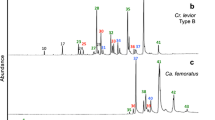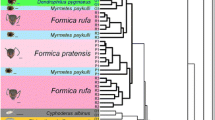Abstract
Some social parasites of insect societies are known to use brute force when usurping a host colony, but most use more subtle forms of chemical cheating either by expressing as few recognition cues as possible to avoid being recognized or by producing similar recognition cues to the host to achieve positive discrimination. The former “chemical insignificance” strategy represents a more general adaptive syndrome than the latter “chemical mimicry” strategy and is expected to be characteristic of early evolutionary stages of social parasitism. We tested this hypothesis by experimentally analyzing the efficiency by which Acromyrmex echinatior leaf-cutting ants recognize intruding workers of the incipient social parasite Acromyrmex insinuator. The results were consistent with the parasite being “chemically insignificant” and not with the “chemical mimicry” hypothesis. Gas chromatography–mass spectrometry analysis of cuticular hydrocarbon profiles showed that social parasite workers produce significantly fewer hydrocarbons overall and that their typical profiles have very low amounts of hydrocarbons in the “normal” C29–C35 range but large quantities of unusually heavy C43–C45 hydrocarbons. This suggests that the C29–C35 hydrocarbons are instrumental in normal host nestmate recognition and that the C43–C45 compounds, all of which are dienes and thus more fluid than the corresponding saturated compounds, may reinforce “chemical insignificance” by blurring any remaining variation in recognition cues.






Similar content being viewed by others

References
Alpert GD, Akre RD (1973) Distribution, abundance, and behavior of the inquiline ant Leptothorax diversipilosus. Ann Entomol Soc Am 66:753–760
Bagneres AG, Lorenzi MC, Dusticier G, Turillazzi S, Clement JL (1996) Chemical usurpation of a nest by paper wasp parasites. Science 272(5263):889–892
Bot ANM, Rehner SA, Boomsma JJ (2001) Partial incompatibility between ants and symbiotic fungi in two sympatric species of Acromyrmex leaf-cutting ants. Evolution 55:1980–1991
Bourke AFG, Franks NR (1995) Social evolution in ants. Princeton University Press, Princeton, New Jersey
Breed MD, Stiller TM, Moor MJ (1988) The ontogeny of kin discrimination cues in the honey bee, Apis mellifera. Behav Genet 18:439–448
Buschinger A (1986) Evolution of social parasitism in ants. Trends Ecol Evol 1(6):155–160
Dahbi A, Lenoir A (1998) Ontogeny of colonial hydrocarbon label in callow workers of the ant Cataglyphis iberica. Behav Ecol Sociobiol 42:349–355
D’Ettorre P, Heinze J (2001) Sociobiology of slave-making ant. Acta Ethol 3:67–82
D’Ettorre P, Errard C, Ibarra F, Francke W, Hefetz A (2000) Sneak in or repel your enemy: Dufour’s gland repellent as a strategy for successful usurpation in the slave-maker Polyergus rufescens. Chemoecology 10:135–142
D’Ettorre P, Mondy N, Lenoir A, Errard C (2002) Blending in with the crowd: social parasites integrate into their host colonies using a flexible chemical signature. Proc R Soc Lond B 269:1911–1918
Elmes GW (1978) A morphometric comparison of three closely related species of Myrmica (Formicidae) including a new species from England. Syst Entomol 3:131–145
Emery C (1909) Über den Ursprung der dulotischen, parasitischen und myrmekophilen Ameisen. Biol Zentbl 29:352–362
Francoeur A, Loiselle R, Buschinger A (1985) Biosystématique de la tribu Leptothoracini (Formicidae, Hymenoptera). 1. Le genre Formicoxenus dans la région holarctique. Nat Can 112:343–403
Gamboa GJ, Reeve HK, Ferguson ID, Wacker TL (1986) Nestmate recognition in social wasps: the origin and acquisition of recognition odours. Anim Behav 34:685–695
Gibbs A, Pomonis JG (1995) Physical properties of insect cuticular hydrocarbons: the effects of chain length, methyl-branching and unsaturation. Comp Biochem Physiol B 112:243–249
Hölldobler B, Wilson EO (2005) The ants. Harvard University Press, Cambridge, MA
Howard RW, Blomquist GJ (2005) Ecological, behavioral, and biochemical aspects of insect hydrocarbons. Annu Rev Entomol 50:371–393
Lahav S, Soroker V, Hefetz A, Vander Meer RK (1999) Direct behavioral evidence for hydrocarbons as ant recognition discriminators. Naturwissenschaften 86:246–249
Lenoir A, Francoeur A, Errard C, Jaisson P (1989) Résultats préliminaires sur le comportement de Formicoxenus provancheri en relation avec son hôte Myrmica incompleta (Hymenoptera Formicidae). Actes Colloques Insectes Sociaux 5:225–232
Lenoir A, Fresnau D, Errard C, Hefetz A (1999) Individuality and colonial identity in ants: the emergence of the social representation concept. In: Detrain C, Deneubourg JL, Pasteels JM (eds) Information processing in social insects. pp 219–237
Lenoir A, D’Ettorre P, Errard C, Hefetz A (2001) Chemical ecology and social parasitism in ants. Annu Rev Entomol 46:573–599
Lorenzi MC, Bagneres AG (2002) Concealing identity and mimicking hosts: a dual chemical strategy for a single social parasite? (Polistes atrimandibularis, Hymenoptera: Vespidae). Parasitology 125(6):507–512
Lorenzi MC, Bagnères AG, Clément JL (1996) The role of cuticular hydrocarbons in social insects: is it the same in paper-wasps? In: Turillazzi S, West-Eberhard MJ (eds) Natural history and evolution of paper wasps. Oxford University Press, London, UK, pp 178–189
Lorenzi MC, Cervo R, Zacchi F, Turillazzi S, Bagnères AG (2004) Dynamics of chemical mimicry in the social parasite wasp Polistes semenowi (Hymenoptera: Vespidae). Parasitology 129:643–651
Lowe RM, Ward SA, Crozier RH (2002) The evolution of parasites from their hosts: intra- and interspecific parasitism and Emery’s rule. Proc R Soc Lond B 269:1301–1305
Mori A, Visicchio R, Sledge MF, Grasso DA, Le Moli F, Turillazzi S, Spencer S, Jones GR (2000) Behavioral assays testing the appeasement allomone of Polyergus rufescens queens during host-colony usurpation. Ethol Ecol Evol 12:315–322
Nelson DR (1993) Methyl-branched lipids in insects. In: Stanley-Samuelson DW, Nelson DR (eds) Insect lipids: chemistry and biology. University of Nebraska Press, Lincoln, NE, pp 271–315
Schultz TR, Bekkevold D, Boomsma JJ (1998) Acromyrmex insinuator new species: an incipient social parasite of fungus-growing ants. Insectes Soc 45:457–471
Stuart RJ (1992) Nestmate recognition and the ontogeny of acceptability in the ant, Leptothorax curvispinosus. Behav Ecol Sociobiol 30(6):403–408
Sumner S, Hughes WOH, Boomsma JJ (2003a) Evidence for differential selection and potential adaptive evolution in an inquiline social parasite. Behav Ecol Sociobiol 54:256–263
Sumner S, Nash DR, Boomsma JJ (2003b) The adaptative significance of inquiline parasite workers. Proc R Soc Lond 270:1315–1322
Sumner S, Aanen DK, Delabie J, Boomsma JJ (2004a) The evolution of social parasitism in Acromyrmex leaf-cutting ants: a test of Emery’s rule. Insectes Soc 51:1–6
Sumner S, Hughes WOH, Pedersen JS, Boomsma JJ (2004b) Ant parasite queens revert to mating singly. Nature 428:35–36
Wilson EO (1971) The insect societies. Harvard University Press, Cambridge, MA
Acknowledgments
This work was supported by the EU Research-Training Network INSECTS (JJB and ST), by grants from the Danish Natural Science Research Council and the Danish National Research Foundation (JJB), and by a grant from the Ente Cassa di Risparmio di Firenze (FRD). Patrizia D’Ettorre and David Nash gave valuable comments on a previous version of the manuscript.
Author information
Authors and Affiliations
Corresponding author
Additional information
Communicated by K. Ross
Rights and permissions
About this article
Cite this article
Lambardi, D., Dani, F.R., Turillazzi, S. et al. Chemical mimicry in an incipient leaf-cutting ant social parasite. Behav Ecol Sociobiol 61, 843–851 (2007). https://doi.org/10.1007/s00265-006-0313-y
Received:
Revised:
Accepted:
Published:
Issue Date:
DOI: https://doi.org/10.1007/s00265-006-0313-y



